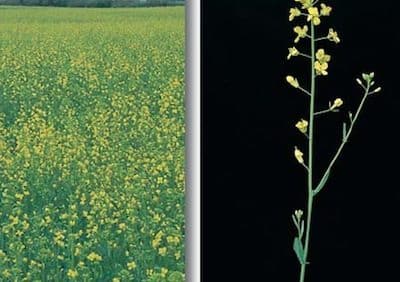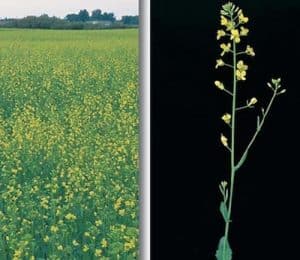1. What is 20 per cent flower? For most fungicides, the window for application is from 20 to 50 per cent flower, with optimum timing typically around 30 per cent flower. At 20 per cent flower, the main stem will have 15 flowers. Consider that canola can reach 20 per cent flower within four or five days after first flower, and petal drop starts after 30 per cent flower. Fifty per cent is “full” flower when a field is at it’s most yellow. Uneven crops or thin crops with larger plants can flower longer, extending the 50 per cent stage. See images and descriptions of the flowering stage (Stage 6).
2. When to spray an uneven crop? Count main stem flowers at a few sites in the field and take an average to come up with flowering stage for the field. For example, if you check 10 random plants and three or four are at 30 per cent flower and some have no flowers, the average is probably around 15 per cent. Split applications may be better if conditions indicate higher risk and the crop has a lot of plants at different stages. The first application can be made when the first plants reach recommended staging. If necessary, a second application can be made when the remaining plants are ready to be sprayed. Even if most of the crop seems to be less mature, an application when those earlier plants are at the right stage may pay off – if the crop is moist and yield potential is good – because those spore-infested petals can land on less mature (pre-flowering) plants and cause infection. Early infection on these less mature plants could cause higher yield loss because the disease will have that much longer to grow. More on later sprays.
3. How much moisture does the disease need? Moisture is the most important risk factor, and canopy conditions need to be moist starting three weeks before flowering and through flowering to cause disease. It would be really helpful to be more specific on how much moisture is enough, but that information is not available. So we have to be general: If the soil surface underneath the canola canopy remains wet for most or all of the day, this promotes germination of sclerotia and production of apothecia, the tiny mushrooms that release sclerotinia spores. AAFC plant pathologist Kelly Turkington provides this rough guide for ideal moisture: Rainfall (of at least 5-10mm) occurring more than two days a week and daily minimum relative humidity (RH) over 80 per cent will increase disease.
Relative humidity (RH) is a good indicator of ample moisture. Humid conditions in the canopy will promote petals sticking to plants, and provide the moisture needed for infection. (Without moisture after petal drop, things dry up and the risk is reduced.) If local weather charts show that RH is staying above 80 per cent for long stretches in June and July, this is a good indicator of favourable moisture conditions. Note that RH levels will typically be higher in the canopy. If you walk through the canopy in early afternoon and your pants get wet, the field has favourable conditions for infection. Conversely, if you walk through the crop at 9 or 10 a.m. and the soil surface and canopy are dry, and your boots and your pants are dry, then conditions are not favourable for stem rot. We call this “wet pants test”. More on risk factors.
4. How does the risk change if the weather is hot and dry versus hot and humid? Hot, dry weather reduces infection rates and the progression of sclerotinia within the plant. The disease risk is limited when current conditions are dry, max daily temps are 30°C or more, and forecast is for this to continue for seven to 14 days. However, sclerotinia risk may remain high if hot weather is humid. Even on hot days, a canola canopy can have its own more-moist micro-climate. Also keep in mind that even though the sclerotinia pathogen does not like to grow over temperatures of 30°C, lower night temperatures will allow for fungal growth. Fungicide may still provide a return.
5. How do you improve fungicide performance? Timing is key. You want to be within the spray window of 20 to 50 per cent flowering (which is the window for most products) and going shortly after 20 per cent flowering will usually provide a higher economic return if moisture conditions favour infection. Water volume is the next most important factor. This article has more details.
To continue the discussion about hot weather, these conditions can increase evaporation of the spray, reducing fungicide performance. Some companies say to avoid spraying in temperatures above 25-27°C. This is another reason to keep water volumes at a minimum of 10 gallons per acre. Coarse spray droplets, in this case, will help to reduce rapid droplet evaporation while still maintaining very good target coverage.
A related question on this theme: When would you use a high-rate of fungicide, if the product offers a high rate option? Kelly Turkington suggests the high rate when all indicators suggest a high risk for disease, and especially in areas where you have had severe sclerotinia in the field or adjacent fields in the recent past. Another factor is high spore loads: If you can easily find abundant apothecia in a short time or have done some petal testing and levels are moderate to high.
6. Why is water volume important for fungicide efficacy? Water improves coverage of the petals and also increases coverage down in the canopy. This podcast includes a discussion on the value of fungicide coverage down in the canopy.
7. When would it make sense to make a second application? Split application provides longer protection if the flowering period is extended due to cool, wet conditions, uneven maturity resulting from staggered emergence, or excessive branching with low plant populations.
Split applications might also be best for crops with a lot of plants at different stages. This was discussed in question 2, above. This article has more.
Fungicides will typically remain active in the tissue they are applied to for two to three weeks. The actual length of time will depend on the product and its persistence, as well as the quality of application and its penetration into the canopy. If a second application is planned, apply seven to 14 days after the first application.
A related question on this theme: If a product can only be sprayed once, can you go a second time with a different active? Yes, that is the preferred approach.
8. Since water volume is important, why use an aerial application? Many fungicides allow for aerial application. Sprayers 101 notes that an aircraft’s chief advantage is to cover large areas with no crop trampling, and can do so even in wet conditions. As a result, they offer the timing advantage that is so important.
Sprayers 101 expands on the aerial option: A producer hiring an aircraft for spraying ought to have a conversation with the pilot and discuss water volume and droplet size. Aircraft, out of practical necessity, apply less water and distribute it in finer sprays to offer the required coverage. Although this has been shown to be effective, it creates drift and evaporation potential. It is worthwhile to ask for higher water volumes if it means that the spray can be applied somewhat coarser, creating less drift. The rotary atomizers on many aircraft produce fairly uniform droplet sizes and do a good job of eliminating the larger droplets. This makes even more droplets available for coverage. However, even with this technology spray drift still matters and all steps to prevent it should be taken. This means using larger average droplet sizes and increasing water volumes accordingly to their label recommendations.
9. The crop was at the right stage to spray and then hail knocked off a lot of the flowers. Should you still spray? If hail occurs during flowering, growers should wait until the crop comes back into flower and re-scout for sclerotinia risk before making a spray decision. Assess yield potential of the crop before considering a fungicide application.
10. Does a hybrid with increased sclerotinia stem rot tolerance need a fungicide? Increased resistance to sclerotinia stem rot, which is available in some canola hybrids, has been compared to “an early half-rate application of fungicide”. This provides some peace-of-mind in years when a person isn’t sure whether a spray will pay. In high-risk situations, these varieties may still benefit from a fungicide application.
Got any other questions? Please send them to us and we’ll look for answers.
More…
- Factors in the sclerotinia spray decision
- Canola Encyclopedia section on sclerotinia stem rot
- Sprayers 101: Fungicide applications in cereal pulse and oilseed crops.
- PODCAST: Expert help for the sclerotinia spray decision


